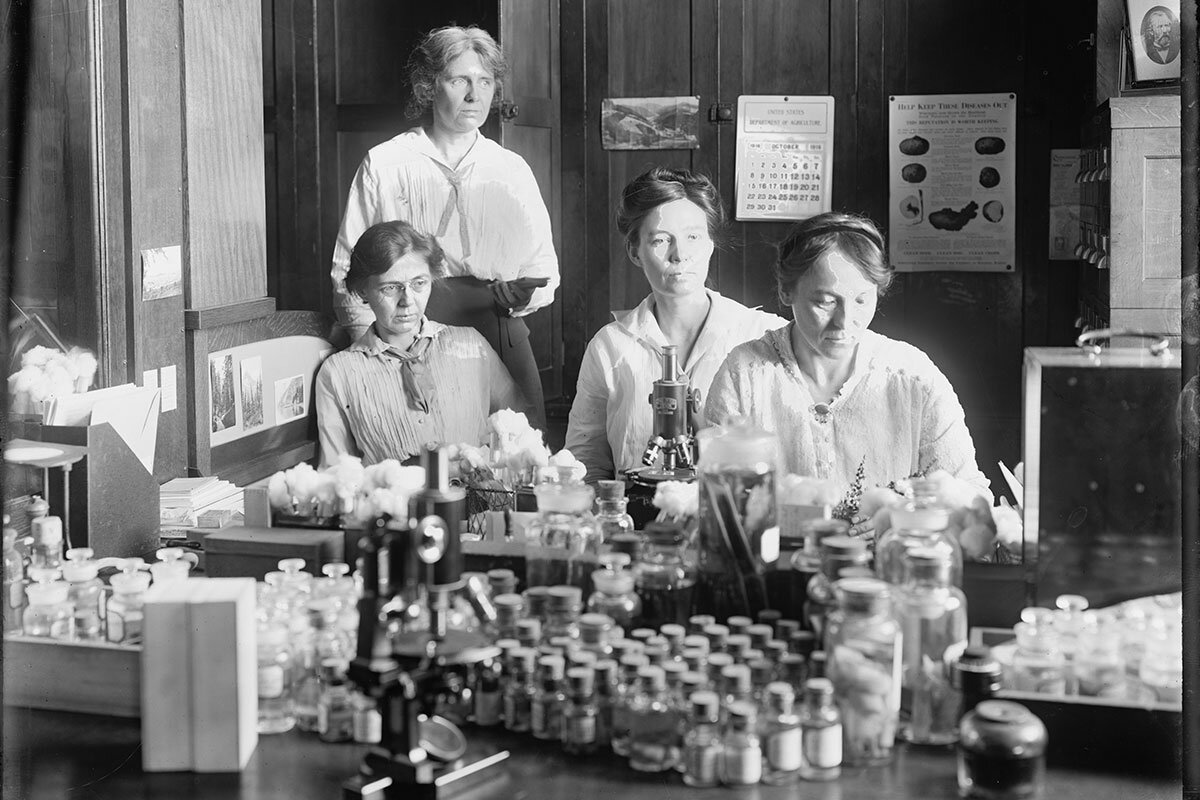Once, when Alison Coil was on a grant review panel, an unusual situation arose: Applications had come in from two people at similar points in their career on similar topics. One was from a white male, the other from a woman of color.
Dr. Coil, an astrophysicist at the University of California in San Diego, remembers the reaction as being mixed. While the women on the panel generally liked the female applicant’s proposal, one white man called it “too ambitious.” The woman didn’t get the funding.
“All it takes, when funding is scarce, is one person raising one concern to knock someone out of first place,” says Coil, who was particularly disturbed at the fraught stereotypes involved in dismissing a woman of color for being “ambitious.”
With movements like #MeToo and #EqualPay putting fresh attention on how women fare in US workplaces, gender equity is getting renewed attention in a wide range of fields. In the sciences, where in some disciplines women hold between just 10 and 20 percent of jobs, there’s been a growing recognition for years – backed by numerous studies – of the biases and barriers that can hinder women’s advancement. As awareness and attention has increased, so too have efforts to address not just sexual harassment, which many women scientists face, but also the subtle but deeply entrenched ways in which women – and minorities – find their work devalued. But in many institutions, women still struggle to get male peers and supervisors to acknowledge the problem.
“The gender biases that pervade all of society can be especially extreme in all fields of endeavor where brilliance is the main idea,” says Risa Wechsler, a cosmologist at Stanford University. Dr. Wechsler cites a 2015 study in which practitioners in different fields were asked whether intrinsic ability or hard work was required for success. “The more brilliant you think you have to be, the more the field is populated by white guys,” she says.
That notion was memorably articulated by Lawrence Summers over a decade ago when he was president of Harvard University and speculated – in widely disparaged remarks – that perhaps “issues of intrinsic aptitude” were responsible for the relatively low number of women in top positions in science. It surfaced again this past summer in the internal memo written by a Google software engineer in which he claimed that “biological differences” are a major reason why there are so few women in tech.
No data have borne out those claims. Numerous studies, meanwhile, have shown ways in which women tend to be viewed differently, even if they have the same accomplishments as male colleagues.
In one 2012 study, faculty were asked to rate the application materials of students applying for a laboratory manager position, who were randomly assigned either a male or female name. They consistently rated the “male” students as more competent than the identical “female” students, and selected a higher starting salary and offered more mentoring to the male student.
Another study found that letters of recommendation for male and female medical faculty differed significantly when it came to the terms used to describe the candidates, the length, and the doubts raised.
Change comes slowly
A big frustration, say many women scientists who have been involved in efforts to fight biases, is the unwillingness on the part of many men to acknowledge the problem. It’s a challenge that may be particularly acute in the sciences, they say, because it attacks such a central core of the discipline: the notion of objectivity.
“If you think you’re objective, and your work is based on objectivity, and there’s this myth of meritocracy, then of course you’re not going to want to hear this,” says Coil.
And almost every woman scientist has had to contend with the widespread notion that she must have been hired mostly because of her gender.
“Women are sometimes explicitly told that, and people of color are definitely told that – that you only got in because you’re a minority,” says Coil. “All it takes is someone saying that to you once in a year to make you question yourself. But what data shows is that on the whole, the bar is higher” for women and minorities.
In terms of barriers, and implicit biases, the same issues emerge repeatedly: Women are asked to do more “soft” tasks – serve on more committees, mentor more students, be “the” female representative. But they don’t get credit for those activities in fields where research and publishing is prized. Women who co-author publications don’t get credit for their work, while male co-authors do. Women are less likely to be nominated for awards or considered for leadership positions or invited to present at conferences.
“So much of your reputation and advancement is based on invitation and recommendation,” says Wechsler. “It’s essentially an old boys’ club.”
But as awareness of these biases increases, things are also starting to change, some women say – maybe not broadly, but in pockets and bright spots at a range of institutions.
At the University of Michigan, many faculty are now required to take workshops that discuss unconscious bias and how to mitigate it. Among other things, search committees there now try to set out a specific list of what they’re looking for and what they want to prioritize before looking at applications.
More science departments around the country are taking a hard look at how they evaluate applications and grants, and making sure they don’t just solicit a token woman or minority applicant, but have a significant number.
The Hubble Space Telescope has started randomizing its review process for applications to use the telescope, changing the order of names so that it’s not clear who the principal investigator is and using initials rather than first names. That has helped reduce the bias it used to have in which men had a higher rate of success with their applications than women.
After the 2016 election, a number of women came together to form “500 Women Scientists” – a grassroots group whose initial goal was to get 500 signatures to an open letter reaffirming their commitment to speaking up for science as well as underrepresented groups. They passed that goal within hours, and now have over 20,000 women who have signed in support, many of whom participate in local “pods” that offer support to each other and take on activism in various ways.
“Change that is sustainable and sticks takes a long time,” says Jane Zelikova, one of the co-founders of 500 Women Scientists, who says she oscillates between being angry and being optimistic. She recently managed to use data to convince a male engineer, who had been skeptical of bias, that asking questions in a different way really can make a difference. “It’s a slow process,” Dr. Zelikova says. “He still pushes back on other things.”
Scientists too
More overt harassment, too, is getting attention in the sciences – including the role it can play in discouraging promising women from certain careers or driving them out of their field.
Two years before the allegations against Harvey Weinstein helped launch the MeToo movement, the astronomy field was shaken when one of its biggest stars – Geoffrey Marcy, a professor at the University of California at Berkeley – had to resign from his job after multiple accusations of sexual harassment from students, stretching back over decades.
This past fall, another well known scientist – geologist David Marchant – was found by Boston University to have sexually harassed a graduate student during field research in Antarctica. He is appealing his termination, though his initial appeal was denied.
Two ingredients make the academic sciences, in particular, ripe for sexual harassment, says Meg Urry, an astrophysicist at Yale University and a former president of the American Astronomical Society. Many of the fields are heavily male-dominated, and there’s a significant hierarchy and power imbalance. “That puts young women in a vulnerable position when they enter a science,” Dr. Urry says.
'What about all the women ...?'
During the fallout from the Geoff Marcy case, one of the things that most bothered Urry was the number of astronomers who talked about what a loss to the field Dr. Marcy’s resignation was. “I’m thinking, what about all the women who didn’t contribute because they left the field” due to Marcy, says Urry. “For every one of these serial predators there are a dozen, maybe several dozen, women whose trajectories have been stopped or badly altered. That’s a huge impact.”
A study published last summer that looked at workplace atmosphere for women in astronomy found that nearly 40 percent of women reported being verbally harassed within the last five years, and 9 percent reported being physically harassed. The problem was particularly acute for women of color, of whom 40 percent reported feeling unsafe at work within the last five years.
“They faced a double jeopardy, not only feeling unsafe because of gender, but also because of race,” says Christina Richey, an astrophysicist and planetary scientist who was one of the authors of the study. “Talk about death by 1,000 cuts. For them it was 2,000 cuts.”
Gilda Barabino, a chemical engineer and dean of the Grove School of Engineering at The City College of New York, says she’s had situations in which white women have dismissed her experience as an African-American woman in the sciences as less important, saying that “gender trumps race” when it comes to discrimination – not something she has always found to be true.
But Dr. Barabino has also found some promising solutions – particularly in the support women can give each other. Years ago, she and a social scientist used a National Science Foundation grant to bring a cohort of women of color in engineering together. Over the course of several years, those 20 women not only came together in the circumstances Barabino organized, but continued to support each other, call each other, and even collaborate on work. Many years later, she says, many have moved into leadership roles and at least 18 are still very active professionally.
“Everywhere I go I make a suggestion to come together as a group,” says Barabino. “I speak to the power of sharing stories and having supportive networks.” When she went through school and rose in her career, there were no support networks, Barabino adds, and she was mostly working just to ensure professional survival.
Now, “there’s a glimmer of hope and some light when you see that the numbers are increasing, or are more than when I went through,” she says. “At the same time, I don’t see systemic change happening.”







